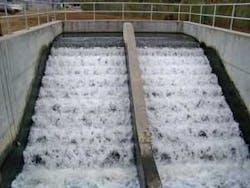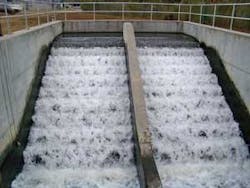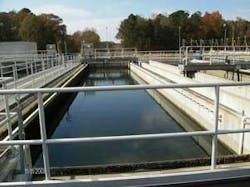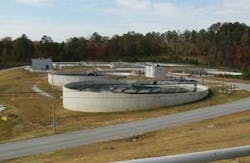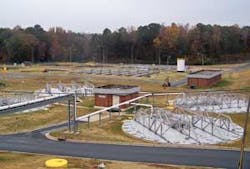Upgraded Plant Reclaims Water for Stream Augmentation
By William Stewart
Challenges faced by the water industry include everything from higher water demand and inadequate water resource supplies, to aging infrastructure and climate change. While the specific supply issues vary from state to state, one thing is certain: water on tap is not a given, but rather the result of careful planning and conservation.
The goal of meeting demand is certainly attainable and is a daily preoccupation of the water industry. Through these efforts, the industry has developed a set of innovative solutions to supply water to growing populations.
Water reuse is one solution. Increasing the amount of reclaimed water for agriculture and commercial consumers will significantly ease the strain on rivers, lakes, and aquifers that provide us with clean and safe drinking water.
American Water Enterprises (AWE), the contract operations and maintenance arm of American Water, led a design-build-operate team that undertook the expansion and renovation of the Camp Creek Water Reclamation Facility in College Park, GA, in 2002-2005. The facility serves residential, commercial, and industrial users in the South Fulton County region. The intent was to reclaim domestic sewage for reuse initially as stream flow augmentation; subsequent reuse will depend on the needs of the rapidly developing surrounding community.
The project involved expanding the original plant from 13 mgd to 24 mgd and renovating the entire facility. During construction of the expansion, AWE operated the existing facility without interruption.
The plant expansion included the headworks and three primary clarifiers. Aluminum salts can be added upstream of the primary clarifiers for phosphorus removal, as required. Chemical precipitation supplements biological removal, while at the original plant chemical precipitation was the primary phosphorus removal method.
Three new biological reactors, using a three-stage anaerobic/anoxic/aerobic process, provide both total nitrogen and biological phosphorus removal. Three secondary clarifiers were constructed to serve the new biological reactors. A splitter box between the reactors and the clarifiers provides flexibility between on-line and off-line units and the new clarifiers employ a flocculation zone center well for best performance.
The plant also includes eight shallow bed, automatic backwashing filters. Seven of the filters can handle the peak flow condition of 60 mgd, with one standby unit. Three UV disinfection channels are on line with one complete standby unit provided for times of peak flow. The new UV reactor channels were constructed as part of a monolithic structure incorporating the filters and UV disinfection. A re-aeration cascade and plant water pumps downstream of the UV system complete the treatment process. The plant effluent is conveyed to an outfall on the Chattahoochee River.
Sludge from the sludge holding tanks is dewatered with two centrifuges in the dewatering building. The solids are landfilled at an off site location and the centrate is recycled into the plant influent.
In addition to the Camp Creek facility, AWE also operates under contract with Fulton County 17 pump stations and the Little Bear Creek Plant, a package treatment facility that serves a residential subdivision.
Conclusion
Water supply management is an issue that affects us all. In the U.S., droughts are occurring in places that have historically had adequate water supplies, while the population is growing and the climate is changing. In Georgia, residents are all aware of the effects of drought, the rapidly expanding Atlanta metropolitan area, and conflicting water demands downstream of Atlanta. And yet, effective solutions have been implemented in only a small percentage of American communities.
It seems that water, for many people, has become a resource that is taken for granted. Research has proven that rampant, excessive use of the water supply will eventually lead to a crisis. From today forward, careful planning and conservation that focuses on long-term stability will be necessary to ensure that successful water management is a reality for everyone. WW
About the Author:
William A. (Bill) Stewart is the General Manager for the Camp Creek Project in the Contract Operations Group for American Water Enterprises (AWE), the non-regulated products and services division of American Water Works Co. Stewart has more than 28 years of experience in every aspect of the water and wastewater business, in the private and public sectors, and in domestic and international venues. He is a registered professional engineer and maintains operator certifications in Georgia for wastewater treatment. For more information, visit www.amwater.com
